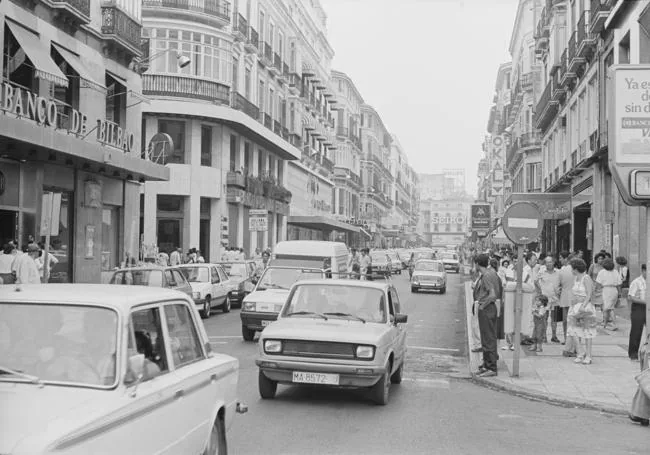The many eras of Malaga's famous Calle Larios
Since its opening at the end of the 19th century, the city's main commercial street has lived through a number of different stages
Víctor Heredia
Malaga
Wednesday, 21 August 2024, 16:09
Calle Larios, in Malaga city, was inaugurated on 27 August 1891. It was born as an expression of the power of the Larios family and with the goal of becoming the city's main street. It was also a step towards modernity. From its very opening, Calle Larios became the de facto meeting point for local 'malagueños', and the evolution of its commercial activity reflects the legacy of the city itself.
This article does not seek to provide an inventory of the hundreds of commercial establishments that have existed in the buildings of Calle Larios, designed by Eduardo Strachan. Rather, we aim to take you through the stages of streets' development over its 130 years of existence.
According to Francisco Bejarano, merchants were at first wary of opening their businesses on the new street. This forced the Larios family to sponsor various societies, businesses and institutions to set up there, including the Círculo Mercantil, the Liceo, the Junta de Obras del Puerto and the Chamber of Commerce.
But this initial reluctance was soon dispelled, and by the beginning of the 20th century, the street was lined with shops where you could find practically anything you wanted. José Cabezas‘ furniture, Pedro Temboury's hardware store, La Riojana's chocolates, Porras’ hairdresser's, Páez' confectioner's, Pérez de Guzmán's chemist's, Enrique Rosado's jewellery shop, Morganti's mouldings and mirrors, Conde y Prados' fabrics, Chico Ganga's shoe shop, Ruiz's men's hat shop and Ana María Florido's women's hat shop. These businesses, alongside the respective factories of Hidalgo Espíldora and Federico Vilches, marked the first stage of the commercial life of Calle Larios.
The 1920s and 1930s were the golden age of cafés and recreational societies. The Círculo Mercantil maintained its luxurious lounges at number 5, the Real Club Automovilista was at number 9, and the Círculo de la Unión Patriótica at number 12. Some of the cafés along the main road included the Imperial, the elegant Inglés (with a restaurant and a ladies' room), the Peninsular, the Pay-Pay, the Comercial, the Español, the Málaga, La Cosmopolita, Bar Plata, La Palma Real and the Cervecería El Mediterráneo.

The renovation of Calle Larios
The idea of opening a street that would connect the Plaza de la Constitución to Malaga's port had already been proposed as part of Moreno Monroy's preliminary expansion project of 1861, although the definitive plan was proposed by Sancha in 1878 and designed by Rucoba. Casa Larios reached an agreement with the Town Hall to execute the works, which were carried out between 1887 and 1891, and the buildings were erected according to plans by Eduardo Strachan. The new road was carefully designed, with gas street lamps and a wooden pavement giving it a distinctive character. The wooden paving stones were destroyed in the 1907 flood. In July 1936, at the outbreak of the Civil War, several of the original buildings were burnt down, before being rebuilt between 1939 and 1940. In 1947, the street lamps were replaced with lights anchored to the façades. The pavement was renovated in 1959, when the first traffic lights were also installed. The last major transformation took place in 2002, when a renovated and pedestrianised Calle Larios was opened, and its street lamps restored.
In 1928, a Madrid newspaper wrote that "Calle de Larios is the main artery of Malaga, its vital centre, the channel through which all Malaga life flows". By then there were even more new businesses: Damián Moragues' shirt shop, Enrique Rivas' bookshop, Raimunda Cavagliani's tobacconist, Antonio Entrambasaguas' opticians, López and Griffo's music shop, Cristóbal Benítez car shop, the Prados Hermanos furniture shop, Alejandro Romero's luxury goods, La Perla's jewellers' and Gómez Hermanos' fabric shop.
In the post-war years new establishments also appeared: the Tourist Office, Casa Mira, Masó fabrics, La Mar Chica brewery, Cosmópolis groceries, La Chavalita confectionery, the Rodolfo Prados radio and electronics shop, Bazar del Fumador, Marcos jewellers, Ceisa clothes shop, Segarra, Parriego and Nicolás shoe shops, Bar Ricardo, Martín Sáenz travel shop and Imperio stationery shop.
The 1960s ushered in a new era. Several buildings were partially transformed into department stores: these included the premises of the Círculo Mercantil at number 3 and the first floor of number 4. Number 10 was entirely occupied by the Gómez Raggio shopping centre. Banks also consolidated their presence: there were as many as nine branches on the street around 1990. Just one café still stood on Calle Larios, and it was a new one, Lepanto. By this point, there were already several clothes shops which were branches of bigger retailers as opposed to independent shops; since then, these have taken over much of Calle Larios.
Today, surrounded by brand names present in any city, Mata pharmacy, Marcos jewellers, Casa Mira and the Arturo kiosk are the only survivors of Calle Larios in times past.
